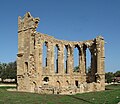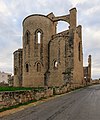Famagusta
|
Famagusta Αμμόχωστος Gazimağusa |
||
|---|---|---|
|
|
||
| Basic data | ||
| State : |
|
|
| District : |
|
|
| Geographic coordinates : | 35 ° 7 ' N , 33 ° 56' E | |
| Residents : | 40,920 (2011) | |
| LAU-1 code no .: | CY-04 | |
| Postal code : | 5000 | |
| Mayor : |
|
|
| Website: | www.magusa.org | |

Famagusta , Greek Αμμόχωστος Ammóchostos ( Turkish Mağusa , renamed Gazimağusa after the Turkish invasion of 1974 ), is a port city on the east coast of Cyprus in the internationally unrecognized Turkish Republic of Northern Cyprus . It is the capital of the Gazimağusa district . Formally it is the capital of the Famagusta district of the Republic of Cyprus .
In ancient times the city was also called Arsinoë after the Egyptian queen Arsinoë II . The Greek term "Ammochostos" means "hidden in the sand"; From this name "Famagusta" or "Mağusa" developed in the Middle Ages.
history
The fishing settlement of Ammochostos gained importance in Byzantine times, when the inhabitants of the neighboring city of Constantia / Salamis to the north moved here after raids by the Arabs , several earthquakes and the silting up of their port. Despite its favorable, deep harbor, the place remained insignificant even under the Byzantines.
The upswing to the richest city in the eastern Mediterranean began in the 13th century after the Frankish crusader Guido von Lusignan , who was King of Jerusalem until 1192 , bought the island of Cyprus from the English king Richard the Lionheart in 1192 in the Third Crusade . After Guido's death in 1194, his older brother Amalrich II took over the rule.
Famagusta became a Catholic bishopric. The city was considered the easternmost outpost of the Roman Church in the Mediterranean. In 1291, after the fall of Acre , nobles, knights, merchants and clerics from Palestine settled on the island. As a trading center with connections to the ports of the Middle East and Italy, Famagusta experienced significant economic, cultural and structural development. In the 14th century the population rose to 40,000. To preserve the prosperity of the merchants required the construction of fortifications. These fortifications were built under Henry II : the citadel at the harbor as a defensive and residential tower ( Othello Tower), in which the events on which the Shakespeare drama is based, and the mighty city fortifications with numerous towers and gates are said to have taken place .
In Famagusta, places of worship were built for all major faiths. From 1291 to 1373 the Cathedral of St. Nikolaos was built in the French Gothic style. The coronation of the Lusignans as kings of the fallen kingdom of Jerusalem and of Cyprus took place here in the 14th century . In the 14th and 15th centuries, the order of knights and the merchant colonies of Syrians, Armenians, Italians, Greeks and Jews built a large number of churches, convents and monasteries, synagogues and mosques around the cathedral. Around 1330 the prosperity of the city and its inhabitants reached its peak.
However, Genoa and Venice grew increasingly in power and influence and competed for supremacy. A riot broke out in the city on the occasion of the coronation of Peter II as King of Jerusalem. There was looting, destruction and a massacre of Genoese merchants. As a result, a squadron under Pietro di Campofregoso occupied the city in 1374 and demanded high reparations and an annual tribute. It was ceded to Genoa by James I. With the help of the Venetians, the Lusignans regained control of Ammochostos in 1464. In 1489, Queen Katharina Cornaro , who came from Venice, ceded rule over the entire island to her hometown.
Under Venetian rule, Ammochostus flourished again briefly. In view of the Ottoman threat, the fortifications were redesigned and reinforced in the Renaissance style from 1491 to 1567 : the approximately 3.5 km long city wall was raised to 17 m and widened to 9 m, a wide moat was created, the Rivettina / Limassol bastions -Tor and Martinengo were placed in front of impressive ravelins from 1544 to 1567 , the sea gate was magnificently redesigned, the citadel was enlarged from 1552 to 1554 and a governor's palace was built in 1552.

In 1570 the Ottoman army under Lala Mustafa Pascha stood in front of the city. After an eleven month siege, the last 500 defenders had to surrender to superiority on August 1, 1571. The Ottomans guaranteed the people's integrity. On August 4, 1571, the city was handed over. On August 5th, the Ottomans broke their promise and killed all Christians. The city was destroyed. The city, hardly damaged in battle, was subsequently destroyed by the conquerors, churches were converted into mosques , including the St. Nikolaos Cathedral in the Lala-Mustafa-Pascha Mosque , other churches were used as warehouses. Famagusta currently has 22 churches, but most of them must be seen as ruins.
Famagusta experienced a new upswing at the end of the 1960s: with increasing tourist interest, after the island was given independence from 1960 onwards, the Varosia district with numerous hotels on the southern outskirts was expanded to become the island's most important tourism center.
The old town of Famagusta played a special role in the Turkish military offensive in 1974 : Many Cypriot Turks had fled from the surrounding area to the old town during the chaos of war and were besieged by the Cypriot National Guard for three and a half weeks . The Turkish armed forces occupied both the city of Famagusta and the touristically important district of Varosia; this was declared a military exclusion zone and should serve as a pledge for later negotiations.
Today's Gazimağusa, with around 40,000 inhabitants, has regained importance as the only cargo port in the Turkish Republic of Northern Cyprus , as a tourist destination and, for several years, as a university town .
education
Culture and sights
The old town is surrounded by a fortress wall from the 16th century that is still largely in its original state. It has a total length of over 3500 meters. Today's center of the old town is the Lala Mustafa Pascha Mosque , which emerged from the St. Nicholas Cathedral shortly after it was conquered through its rededication. This was a main church of the Lusignan, built in 1326 by French builders as a three-aisled basilica. A portico made of three round arches and four Ionic granite columns leads to the Palazzo del Provveditore , the former official seat of the Venetian city commander - today a ruin. Adjacent to this are the ruins of a Franciscan monastery, as well as the St. Peter & Paul Church (Sinan Pasha Mosque), built in 1360. Palaces of crusaders and wealthy merchants are mostly preserved in the old town as ruins. The Paşa Hammam bathhouse also dates from the Arab period , but is now used as a bar.
The Namık Kemal City Museum preserves numerous finds from the city's history, and in a separate room is the Canbulat grave adorned with military insignia and flags .
Town twinning
Church ruins in Famagusta
St. George Church of the Latins (1302–1307)
Carmelite Church (1366)
traffic
The city was the main station on the Famagusta – Morphou railway, which existed from 1904 to 1951 .
economy
Famagusta was considered an important trading port and was the main branch of several shipping companies. The city is also one of the main tourist sites of the Turkish Republic of Northern Cyprus. There are twelve hotels in the city.
Sports
Famagusta was the home of the football clubs Anorthosis Famagusta and Nea Salamis Famagusta , but they migrated to Larnaka after the Turkish invasion. Anorthosis won the national championship six times during his time in Famagusta ( 1950 to 1963 ); since 1995 another seven championship titles have followed in exile. Anorthosis Famagusta made it into the Champions League in 2008 .
From the TRNC , the club is Mağusa Türk Gücü active. The association was founded in 1945 by the Turkish Cypriot population of the city. The team plays its games in the Dr. Fazıl Küçük Stadium with a capacity of 5,000 seats.
Sons and daughters
- Philip Arestis (* 1941), British economist
- Dimitris Papadakis (* 1966), Greek Cypriot politician
literature
- Michalis Olympios: The Shifting Mantle of Jerusalem: Ecclesiastical Architecture in Lusignan Famagusta / Saint George of the Greeks and Its Legacy: A Facet of Urban Greek Church Architecture in Lusignan Cyprus , in: Annemarie Weyl Carr (ed.): Famagusta , vol. 1 : Art and Architecture (= Mediterranean Nexus 1100–1700. Conflict, Influence and Inspiration in the Mediterranean Area , 2), Brepols, Turnhout 2014, pp. 75–142 and 143–202. ( academia.edu )
- Benjamin Arbel : Port Dredging in the Venetian Stato da Mar: the Case of Famagusta (1489–1571) , in: Epetirida 37 (2015) 103–144.
- Benjamin Arbel: Elijah of Pesaro's Description of Famagusta (1563) , in: Gilles Grivaud, George Tolias (eds.): Cyprus at the Crossroads. Geographical Perceptions and Representations from the Fifteenth Century , Sylvia Ioannou Foundation, Athens 2014, pp. 123-136.
- Benjamin Arbel: Maritime Trade in Famagusta during the Venetian Period (1474–1571) , in: Michael JK Walsh, Tamas Kiss, Nicholas Coureas (eds.): The Harbor of all this Sea and Realm. Crusader to Venetian Famagusta , Budapest 2013, pp. 91-103.
- Benjamin Arbel: What happened to the Jews of Famagusta following the Ottoman Conquest of 1571? , in: Benjamin Arbel (Ed.): Minorities in Colonial Settings: the Jews in Venice's Hellenic Territories , London 2012, pp. 241–249.
- Michele Bacci: L'arte delle società miste del Levante medievale: tradizioni storiografiche a confronto . In: AC Quintavalle (ed.): Medioevo: arte e storia , Proceedings of the International Symposium (Parma, September 18–22, 2007), Electa, Milan 2008, pp. 339–354, 6. ISBN 978-88-370- 6695-6
- Michael JK Walsh, Peter W. Edbury, Nicholas SH Coureas (Eds.): Medieval and Renaissance Famagusta. Studies in Architecture, Art and History , Ashgate, Farnham 2012. ISBN 978-1-4094-3557-0 ( limited preview in Google book search)
- Michele Bacci: Syrian, Palaiologan, and Gothic Murals in the “Nestorian” Church of Famagusta , Deltion tes christianikes archaeologikes hetaireias , ser. IV, 27, 2006, pp. 207-220
- Socrates Stratis, Ed .: Guide to Common Urban Imaginaries – The “Hands-on Famagusta” Initiative, JOVIS Verlag Berlin 2016, ISBN 978-3-86859-420-1
Web links
Remarks
- ↑ You can recognize this Italian-influenced Renaissance fortress architecture as the backdrop for many adventure films from the 1960s.
- ↑ According to tradition, the Ottoman officer sacrificed his life in order to make a barrier built by the defenders that had previously been insurmountable unusable. This moment of confusion gave the Ottoman attackers the opportunity to penetrate the fortress. Canbulat has been revered as a war hero ever since.
- ↑ a b c Archive link ( Memento from April 2, 2015 in the Internet Archive )













